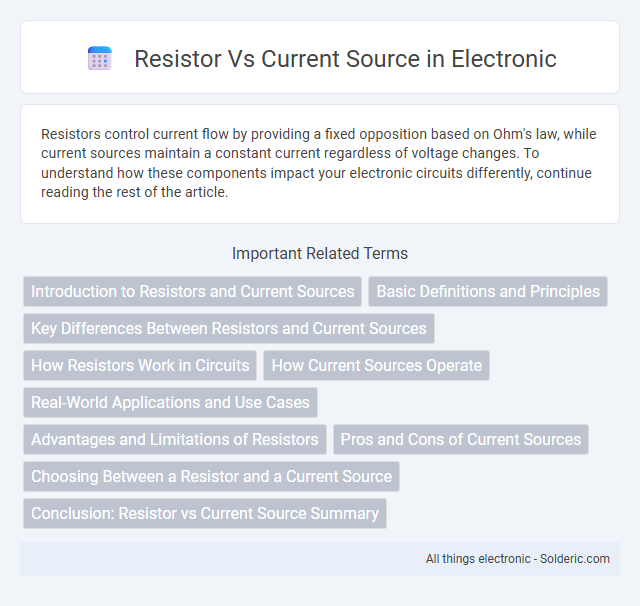Resistors control current flow by providing a fixed opposition based on Ohm's law, while current sources maintain a constant current regardless of voltage changes. To understand how these components impact your electronic circuits differently, continue reading the rest of the article.
Comparison Table
| Feature | Resistor | Current Source |
|---|---|---|
| Definition | Passive electrical component that opposes current, causing voltage drop. | Active device that delivers constant current regardless of voltage. |
| Function | Limits current flow based on Ohm's Law (V = IR). | Maintains a fixed current output independently of load. |
| Symbol | Jagged line or rectangle. | Circle with arrow indicating current flow. |
| Type | Passive component. | Active source. |
| Current Control | Varies with voltage and resistance. | Constant current supply. |
| Voltage Behavior | Voltage varies with current and resistance. | Voltage adjusts to sustain fixed current. |
| Applications | Current limiting, voltage division, biasing circuits. | Current regulation, sensor excitation, analog circuits. |
| Energy Source | Consumes power, dissipates as heat. | Requires external power supply. |
Introduction to Resistors and Current Sources
Resistors regulate electric current by providing a fixed resistance, following Ohm's law to control voltage and current flow within circuits. Current sources deliver a constant current regardless of voltage variations, making them essential for applications requiring stable current supply. Understanding their fundamental roles enables precise circuit design and performance optimization.
Basic Definitions and Principles
A resistor is a passive electrical component that opposes current flow by providing a fixed amount of resistance measured in ohms (O), following Ohm's law (V = IR) where voltage drop is proportional to current. A current source, in contrast, is an active element designed to provide a constant current regardless of the voltage across its terminals, ideal for maintaining steady current in a circuit. Understanding how a resistor linearly limits current while a current source enforces constant current helps you design and analyze circuits with predictable characteristics.
Key Differences Between Resistors and Current Sources
Resistors limit current flow by providing a fixed resistance measured in ohms (O), whereas current sources deliver a constant current regardless of voltage variations, typically specified in amperes (A). A resistor's voltage drop depends on the current through it following Ohm's Law (V=IR), while an ideal current source maintains current independent of voltage across its terminals. Resistors are passive components that dissipate energy as heat, whereas current sources actively regulate current and often require external power to operate.
How Resistors Work in Circuits
Resistors control current flow in circuits by providing a specific resistance measured in ohms, which limits the amount of electric current passing through. According to Ohm's Law, the voltage drop across a resistor is directly proportional to the current flowing through it, enabling precise management of electrical signals and power dissipation. Unlike current sources that maintain constant current regardless of voltage, resistors adjust current based on the voltage applied, playing a crucial role in circuit design and protection.
How Current Sources Operate
Current sources operate by maintaining a constant current regardless of the voltage across their terminals, using internal feedback mechanisms to adjust voltage accordingly. Unlike resistors, which follow Ohm's Law where current varies with voltage, current sources deliver a fixed current defined by their design specifications. This characteristic enables precise control in circuits requiring stable current flow, such as biasing transistors or LED driving applications.
Real-World Applications and Use Cases
Resistors are commonly used in voltage dividers, current limiting, and biasing circuits across consumer electronics and industrial equipment due to their predictable linear behavior. Current sources find applications in precision analog circuits, such as LED drivers, sensor biasing, and transconductance amplifiers, where constant current regulation is crucial despite voltage variations. In power management and sensor interfaces, the choice between a resistor and a current source directly affects efficiency, accuracy, and thermal management.
Advantages and Limitations of Resistors
Resistors offer simplicity and reliability in controlling current by providing a fixed resistance, making them cost-effective and easy to implement in circuits. Their main limitation lies in their inability to provide a constant current under varying voltage conditions, leading to power dissipation and energy loss as heat. You should consider these factors when choosing between resistors and current sources for precise current regulation needs.
Pros and Cons of Current Sources
Current sources provide a constant current regardless of voltage changes, making them ideal for applications requiring stable current such as LED driving and sensor circuits. They offer high precision and efficiency but tend to be more complex and costly compared to resistors, which are simple, inexpensive, and reliable for limiting current but cannot maintain constant current under varying load conditions. Current sources can generate heat and require careful design to avoid instability or damage in circuits with rapidly changing voltages.
Choosing Between a Resistor and a Current Source
Choosing between a resistor and a current source depends on the desired control over current flow and voltage stability in a circuit. Resistors provide a fixed relationship between voltage and current based on Ohm's Law, suitable for simple, linear applications with predictable loads. Current sources maintain a constant current regardless of voltage changes, ideal for precision applications requiring stable current supply despite varying load conditions.
Conclusion: Resistor vs Current Source Summary
Resistors regulate current by providing a fixed opposition to electrical flow, making them essential for controlling voltage and limiting current in circuits. Current sources deliver a constant current regardless of voltage variations, ideal for precision applications requiring stable current supply. Choosing between a resistor and a current source depends on the need for either fixed resistance with variable current or a steady current output independent of load changes.
resistor vs current source Infographic

 solderic.com
solderic.com